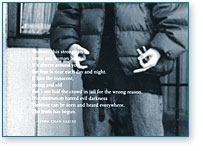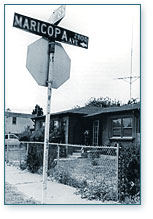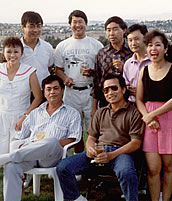 While many Americans have welcomed Southeast Asian refugees and immigrants into their homes and their communities, this has not always been the case. In some cases, newcomers have faced harsh verbal harassment and even physical violence. Southeast Asians have been the victims of hate-crimes, and in some instances, other Asian Americans mistakenly identified as Southeast Asians have been victimized. While some antagonism is based on racial prejudice, some stems from bitterness resulting from the Vietnam War. At other times it is a result of economic competition and cultural misunderstandings. Some Americans still object to the presence of Southeast Asians in the United States and believe the negative stereotypes that exist. While many Americans have welcomed Southeast Asian refugees and immigrants into their homes and their communities, this has not always been the case. In some cases, newcomers have faced harsh verbal harassment and even physical violence. Southeast Asians have been the victims of hate-crimes, and in some instances, other Asian Americans mistakenly identified as Southeast Asians have been victimized. While some antagonism is based on racial prejudice, some stems from bitterness resulting from the Vietnam War. At other times it is a result of economic competition and cultural misunderstandings. Some Americans still object to the presence of Southeast Asians in the United States and believe the negative stereotypes that exist.
 In dense urban areas, refugees were sometimes placed in poor, multiracial African American and Latino neighborhoods where housing was affordable. Long-time residents resented having to compete with the newcomers for housing, jobs, or social services. In other cases, Anglo Americans have harassed Southeast Asians because of their cultural customs. Individuals have faced racial taunts and endured physical attacks, or have even been senselessly murdered. Homes and businesses have been vandalized and defaced with racial epithets. In some areas, violence among youth in the schools and in the neighborhoods has been intense, leading Southeast Asian youths to form or join gangs to protect themselves. In dense urban areas, refugees were sometimes placed in poor, multiracial African American and Latino neighborhoods where housing was affordable. Long-time residents resented having to compete with the newcomers for housing, jobs, or social services. In other cases, Anglo Americans have harassed Southeast Asians because of their cultural customs. Individuals have faced racial taunts and endured physical attacks, or have even been senselessly murdered. Homes and businesses have been vandalized and defaced with racial epithets. In some areas, violence among youth in the schools and in the neighborhoods has been intense, leading Southeast Asian youths to form or join gangs to protect themselves.
For example, Cambodian American youths in Long Beach, California have faced intense conflict with African American and Latino youths. Southeast Asian Americans do not always report these incidents because they fear the police or are afraid of further retaliatory violence by the perpetrators. Communities have organized to prevent further incidents of violence, to ensure that these cases are properly prosecuted, to educate the public about misconceptions about their group, and to build coalitions with other racial groups. It is a slow process, given the linguistic barriers and the mistrust that exists between groups.  
|


 While many Americans have welcomed Southeast Asian refugees and immigrants into their homes and their communities, this has not always been the case. In some cases, newcomers have faced harsh verbal harassment and even physical violence. Southeast Asians have been the victims of hate-crimes, and in some instances, other Asian Americans mistakenly identified as Southeast Asians have been victimized. While some antagonism is based on racial prejudice, some stems from bitterness resulting from the Vietnam War. At other times it is a result of economic competition and cultural misunderstandings. Some Americans still object to the presence of Southeast Asians in the United States and believe the negative stereotypes that exist.
While many Americans have welcomed Southeast Asian refugees and immigrants into their homes and their communities, this has not always been the case. In some cases, newcomers have faced harsh verbal harassment and even physical violence. Southeast Asians have been the victims of hate-crimes, and in some instances, other Asian Americans mistakenly identified as Southeast Asians have been victimized. While some antagonism is based on racial prejudice, some stems from bitterness resulting from the Vietnam War. At other times it is a result of economic competition and cultural misunderstandings. Some Americans still object to the presence of Southeast Asians in the United States and believe the negative stereotypes that exist.  In dense urban areas, refugees were sometimes placed in poor, multiracial African American and Latino neighborhoods where housing was affordable. Long-time residents resented having to compete with the newcomers for housing, jobs, or social services. In other cases, Anglo Americans have harassed Southeast Asians because of their cultural customs. Individuals have faced racial taunts and endured physical attacks, or have even been senselessly murdered. Homes and businesses have been vandalized and defaced with racial epithets. In some areas, violence among youth in the schools and in the neighborhoods has been intense, leading Southeast Asian youths to form or join gangs to protect themselves.
In dense urban areas, refugees were sometimes placed in poor, multiracial African American and Latino neighborhoods where housing was affordable. Long-time residents resented having to compete with the newcomers for housing, jobs, or social services. In other cases, Anglo Americans have harassed Southeast Asians because of their cultural customs. Individuals have faced racial taunts and endured physical attacks, or have even been senselessly murdered. Homes and businesses have been vandalized and defaced with racial epithets. In some areas, violence among youth in the schools and in the neighborhoods has been intense, leading Southeast Asian youths to form or join gangs to protect themselves.